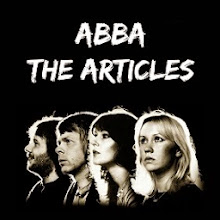 In show business, everyone is playing hardball. Anyone who rests on his laurels will find that he will be rushed off his feet very soon. One swallow does not make a summer, one hit does not make an international pop group. After their triumph with ‘Waterloo’, ABBA was looking desperately for a new hit record. Or rather: first they tried their luck with an ‘oldie’: ‘Ring Ring’.
In show business, everyone is playing hardball. Anyone who rests on his laurels will find that he will be rushed off his feet very soon. One swallow does not make a summer, one hit does not make an international pop group. After their triumph with ‘Waterloo’, ABBA was looking desperately for a new hit record. Or rather: first they tried their luck with an ‘oldie’: ‘Ring Ring’.One year earlier, the song indeed became successful in continental Europe, but not in the UK. But now ABBA gave it another try. ‘Ring Ring’ was revamped, it was made poppier. The signs were good. ABBA was going to perform the song on the BBC’s most popular entertainment show Top Of The Pops. You couldn’t wish for a better promotional opportunity than that. When the four Swedes arrived in London, it turned out that the BBC technicians were on strike.
The next string on their bow would be ‘Honey, Honey’. The song appeared on the same album on which ‘Waterloo’ had been included as well.
‘Honey, Honey’ made it to number two on the German charts, in Belgium it even shot to number one. In the UK, the song reached number six in the charts – but it was the cover version of the British group Sweet Dreams. Despite their victory in the international Song Contest, Merry Old England didn’t seem to like the four Swedes very much.
“We really had to fight for it in England,” Björn remembers. And he continues: “In the beginning, the British newspapers wrote very little about us.” However, when they did write something, it was in the vein of: ‘Poor old ABBA’. For instance, Melody Maker wrote about the ABBA song ‘I Do’: “It’s so bad, it hurts...”.
Not only the newspapers – so it seemed – had turned their backs on the four Swedes. The music industry was doing everything to cut the ground from under foreign artists’ feet as well. Björn: “Whenever we performed on Top Of The Pops, we were not allowed to use playback, because no British musicians had been involved in the recording. Of course, British groups did use playback.”
It wasn’t until ‘Mamma Mia’ hit number one on the British charts in January 1976 that things were starting to look up for ABBA.
On the other hand, things were quite different in the USA. Although they only performed on the Mike Douglas Show during their first visit in September 1974 and they only shook hands with strangers at press gatherings. But during their second outing in November 1975 they performed on seven television shows in two weeks time.
 Everything was going ABBA’s way at this point. Their records were selling like hot cakes, their concerts were sold out. But there were still a couple of thousand miles between them and the location of their biggest triumph: the distance between Sweden and Australia.
Everything was going ABBA’s way at this point. Their records were selling like hot cakes, their concerts were sold out. But there were still a couple of thousand miles between them and the location of their biggest triumph: the distance between Sweden and Australia.The fifth continent was namely the scene of something that ABBA could not have imagined in their wildest dreams. What the Australian newspapers were writing was definitely not a hoax, but reality. They said: “ABBA is the most exciting thing that has hit Australia since the hurricane Tracy.”
Just like everywhere else, the big success in Australia had started with ‘Waterloo’. After that it was blow upon blow. In six months time, the four Swedes sold 1 million records – half of them were albums. When they appeared on television with their song ‘Mamma Mia’, the telephone lines of the broadcasting company broke down, and in the stores the records were literally snatched out of the shop assistants’ hands.
At the invitation of the commercial TV station Channel 9, Agnetha, Anni-Frid, Björn and Benny paid a visit to Australia for the first time in March 1976.
“When we got off the plane in Melbourne, I was looking at Anni-Frid,” Agnetha remembers. “She had tears in her eyes. Just like me. The people in Australia were fantastic. It was a pleasure to be there.”
The highlight of ABBA’s visit was a 45-minute television show. 58 percent of Australian television viewers were fixed to their screens when it was broadcast. More people than had watched the moon landing.
In April 1975, exactly one year after their Brighton triumph, ABBA’s third album was released. Meanwhile, they had been established as an international pop group. Four unknown Swedish musicians had turned into stars, one hit had turned into many hits.
Things were looking up for ABBA in England too. ‘Mamma Mia’ reached the top of the charts, but its successor ‘Fernando’ came as a real bombshell. The British music magazines were starting to realize that ABBA was a force to be reckoned with. There was no talk anymore about ‘poor old ABBA’.



No comments:
Post a Comment